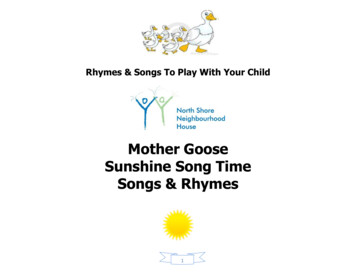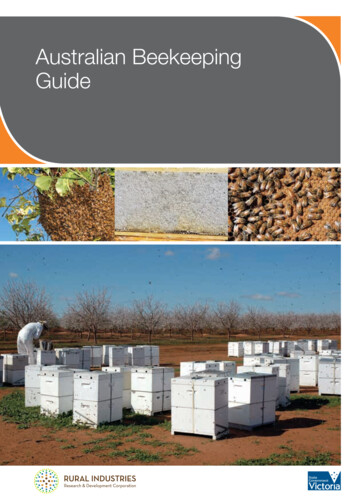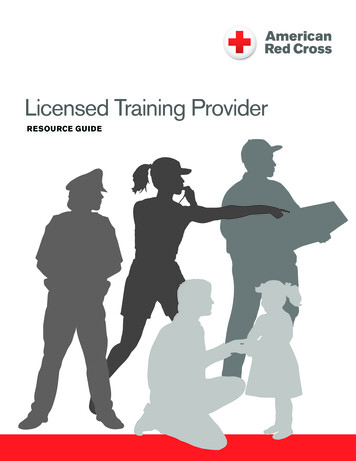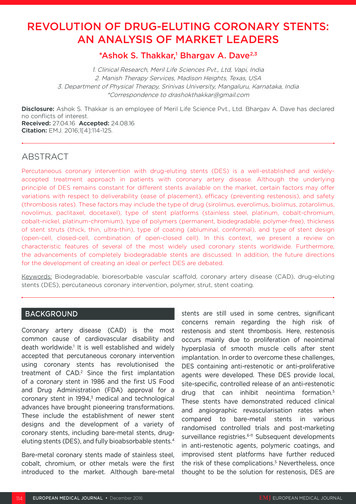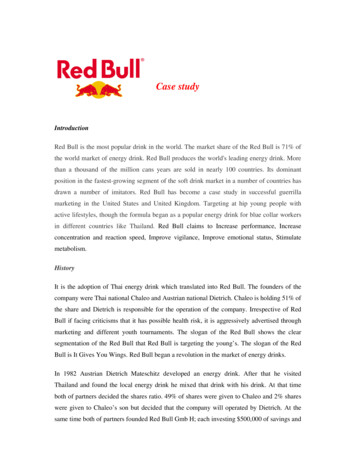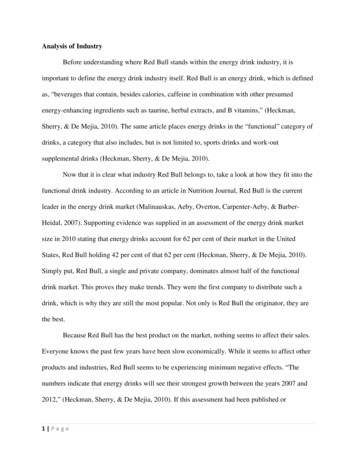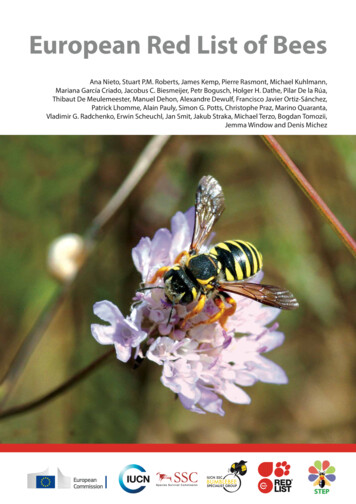
Transcription
European Red List of BeesAna Nieto, Stuart P.M. Roberts, James Kemp, Pierre Rasmont, Michael Kuhlmann,Mariana García Criado, Jacobus C. Biesmeijer, Petr Bogusch, Holger H. Dathe, Pilar De la Rúa,Thibaut De Meulemeester, Manuel Dehon, Alexandre Dewulf, Francisco Javier Ortiz-Sánchez,Patrick Lhomme, Alain Pauly, Simon G. Potts, Christophe Praz, Marino Quaranta,Vladimir G. Radchenko, Erwin Scheuchl, Jan Smit, Jakub Straka, Michael Terzo, Bogdan Tomozii,Jemma Window and Denis Michez
Published by the European CommissionThis publication has been prepared by IUCN (International Union for Conservation of Nature).The designation of geographical entities in this book, and the presentation of the material, do not imply the expression of anyopinion whatsoever on the part of the European Commission or IUCN concerning the legal status of any country, territory, orarea, or of its authorities, or concerning the delimitation of its frontiers or boundaries. The views expressed in this publication donot necessarily reflect those of the European Commission or IUCN.Citation:Nieto, A., Roberts, S.P.M., Kemp, J., Rasmont, P., Kuhlmann, M., García Criado, M.,Biesmeijer, J.C., Bogusch, P., Dathe, H.H., De la Rúa, P., De Meulemeester, T., Dehon,M., Dewulf, A., Ortiz-Sánchez, F.J., Lhomme, P., Pauly, A., Potts, S.G., Praz, C., Quaranta,M., Radchenko, V.G., Scheuchl, E., Smit, J., Straka, J., Terzo, M., Tomozii, B., Window, J.and Michez, D. 2014. European Red List of bees. Luxembourg: Publication Office of theEuropean Union.Design and layout:Imre Sebestyén jr. / UNITgraphics.comPrinted by:Rosseels PrintingPicture credits on cover page:Trachusa interrupta (Endangered) P. Niolu.All photographs used in this publication remain the property of the original copyright holder (see individual captions for details).Photographs should not be reproduced or used in other contexts without written permission from the copyright holder.Available from:Luxembourg: Publications Office of the European Union, http://bookshop.europa.euIUCN Publications Services, www.iucn.org/publicationsA catalogue of IUCN publications is also available.Europe Direct is a service to help you find answersto your questions about the European UnionFreephone number (*):00 800 6 7 8 9 10 11(*) Certain mobile telephone operators do not allow access to 00 800 numbers or these calls may be billedMore information on the European Union is available on the Internet (http://europa.eu).Cataloguing data can be found at the end of this publication.Luxembourg: Publications Office of the European Union, 2014ISBN: 978-92-79-44512-5DOI: 10.2779/77003 European Union, 2014Reproduction of this publication for educational or other non-commercial purposes is authorised without prior written permissionfrom the copyright holder provided the source is fully acknowledged. Reproduction of this publication for resale or other commercialpurposes is prohibited without prior written permission of the copyright holder.Printed in BelgiumThe text of this book is printed on 130 gsm 100% recycled paper (CyclusPrint, FSC and EU Ecolabel certified)
Table of contentsForeword. ivAcknowledgements. vExecutive summary. viii1. Background. 11.1 The European context. 11.2 European bees: diversity and endemism. 21.3 Bee ecology. 31.4 Importance of bees in pollination. 61.5 Assessment of species extinction risk . 61.6 Objectives of the assessment. 72. Assessment methodology. 82.1 Geographic scope. 82.2 Taxonomic scope . 82.3 Assessment protocol. 82.4. Species mapping . 83. Results. 103.1 Threat status. 103.2 Status by taxonomic group . 133.3 Spatial distribution of species. 183.4 Major threats to bees in Europe . 213.5 Population trends. 233.6 Gaps in knowledge . 254. Conservation measures. 264.1 Biodiversity protection in Europe and the EU. 264.2 Conservation of bee species in the EU . 264.3 Conservation of bee species at the national level. 274.4 Extinction risk versus conservation status. 284.5 Red List versus priority for conservation action. 295. Recommendations . 305.1 Policy recommendations. 305.2 Application of project outputs . 315.3 Future work . 31References. 33Appendix 1. Red List status of European bees. 42Appendix 2. Example of species summary and distribution map. 78iii
ForewordEurope’s landscape hasbeen shaped by centuriesof diverse farming andforestry traditions. Thishas resulted in a widerange of agricultural andwoodland landscapes andsignificantly contributedtothecontinent’sbiodiversity. In addition,the EU’s OutermostRegions and Europe’s Overseas Countries and Territoriesare situated in five biodiversity hotspots, including areasthat host over 20% of the world’s coral reefs and lagoons,and 70% of the EU’s biodiversity.In recent years, the decline of pollinators has garneredincreased public attention. Indeed, insect pollination,which is currently under threat in Europe, has an estimatedeconomic value of 15 billion per year in the EU alone.Unfortunately, however, the value of natural capital toour economies and societies, and the interdependencies ofnature with other societal objectives, are often not reflectedin private and public decisions, indicators and accountingsystems in the same way as economic and human capital.The European Red List of Bees provides, for the first time,factual information on the status of all bees in Europe,nearly 2,000 species. This new assessment shows us that9% of bees are threatened with extinction in Europe mainlydue to habitat loss as a result of agriculture intensification(e.g., changes in agricultural practices including the use ofpesticides and fertilisers), urban development, increasedfrequency of fires and climate change.Biodiversity loss is an enormous challenge in the EU, withEurope’s species richness currently highly threatened byhuman activities. Progress has been made on a number offronts: certain populations and distributions of wildlifespecies are showing positive trends, with some speciesthat were once at risk of extinction now stabilising oreven increasing. The Birds and Habitats Directives, thecornerstone of the EU’s nature policies, have clearlyhelped bird species and some large carnivore species torecover in Europe, which is encouraging.To conclude, I must recognize that when undertakingthis assessment, I was struck by the very limited numberof experts on wild bees in Europe and would strongly callfor more investment in this important field of scientificresearch and also for more engagement of all parts ofour society to help strengthen the knowledge neededto reverse these negative trends. We need to ensure farreaching actions to help boost pollinator populations,which will bring huge benefits not only to wildlife andthe countryside, but also to our food producers.However, many of Europe’s ecosystems are now soheavily degraded that their ability to deliver valuableecosystem services has been drastically reduced. The EUBiodiversity Strategy adopted in 2011 is part of a 2050vision aiming to protect, value and restore biodiversityand the services it provides – its natural capital. This isimportant not only to protect nature’s intrinsic value, butalso for its essential contribution to human wellbeing andeconomic prosperity, and to avert catastrophic changescaused by the loss of biodiversity.Pia BucellaDirectorDirectorate B: Natural CapitalEuropean Commissioniv
AcknowledgementsAll of IUCN’s Red Listing processes rely on thewillingness of scientists to contribute and pool theircollective knowledge to make the most reliable estimatesof species status. Without their enthusiastic commitmentto species conservation, this kind of regional overviewwould not be possible.The European Red List of bees and consequently thisreport were requirements of the framework of threeservice contracts with the European Commission(Service Contract No. B2, 070307/2013/661306/SER/B2). In particular, we would like to thank Anne Teller(European Commission) for her support throughout theproject, allowing for a smooth implementation.Coordination of the European Red List of bees wascarried out by Ana Nieto (IUCN European UnionRepresentative Office) with great support from JamesKemp and Mariana García Criado. It greatly benefitedfrom the support of the EC FP 7 project ‘Status andtrends of European Pollinators’ (STEP), which providedcoordination support and expert advice. We would like toparticularly thank Koos Biesmeijer and Simon Potts fortheir assistance, Pierre Rasmont for his enthusiasm andmapping support, and Stuart Roberts and Denis Michezfor their expertise, great dedication and commitmentto the project from start to finish. The project alsocollaborated with the IUCN SSC Bumblebee SpecialistGroup.The European Red List of bees is entirely dependent on alarge number of experts from many different countries inEurope, who generously gave their time and knowledgeand whose contribution is detailed below. The enthusiasmand commitment of these people have enabled us togenerate a comprehensive and detailed picture of beestatus and trends in Europe. We record our thanks tothe following people, asking for forgiveness from anyonewhose name is inadvertently omitted or misspelled: Petr Bogusch, University of Hradec Králové (CzechRepublic): assessor of Biastes, Epeolus, Epeoloides,Icteranthidium, Parammobatodes, Pasites, Trachusa,Sphecodes, Ammobates, Ammobatoides, Schmiedeknechtiaand Chiasmognathus species. Maria Bouga, Agricultural University of Athens(Greece): assessor of Apis mellifera. Ralph Buechler, Landesbetrieb LandwirtschaftHessen (Germany): assessor of Apis mellifera. Eliza Cauia, Asociația Crescătorilor de Albine dinRomânia (Romania): assessor of Apis mellifera. David Baldock (UK): provider of information onbees from Portugal. Björn Cederberg (Sweden): assessor of all Bombusspecies. Cecilia Costa, Consiglio per la Ricerca e lasperimentazione in Agricoltura (Italy): assessor of Apismellifera. Karl Crailsheim, Karl Franzens Universität (Germany):assessor of Apis mellifera. Holger H. Dathe, Senckenberg DeutschesEntomologisches Institut (Germany): assessor of allHylaeus species. Pilar De la Rúa, University of Murcia (Spain): assessorof Apis mellifera. Thibaut De Meulemeester, Naturalis (the Netherlands):assessor of Andrena species.Craig Hilton-Taylor and Jean-Christophe Vié providedguidance, encouragement, and good advice throughoutthe project. Ackbar Joolia and Jemma Windowprovided high-quality support on GIS, and DavidAllen, Rebecca Miller, Melanie Bilz, Catherine Sayerand Caroline Pollock on database support and RedListing guidance.We would like to thank Melanie Bilz, Ana Nieto andJames Kemp for their facilitation at the workshops,and Silvia Sánchez and Andrea Pino del Carpio fortheir extensive help with project administration. AnnaRosenberg and Seifu Habtemichael provided substantialassistance with financial management of the project.A word of thanks goes to Angelika Pullen, Lynne Labanneand Ewa Magiera for their support on communicationrelated matters.We are grateful to Mike Brown and Peter BorgenSørensen for their assistance with writing the section onthreats of this publication and to the photographers, whoprovided species photos for the species assessments andthe photos to illustrate this publication.v
Manuel Dehon, University of Mons (Belgium):assessor of Amegilla, Ancyla, Anthophora, Habropoda,Melecta and Thyreus species. Alexandre Dewulf, University of Mons (Belgium):assessor of all Megachile species. Paolo Fontana, Edmund Mach Foundation (Italy):assessor of Apis mellifera. David Genoud (France): contributor to Andrenaspecies. Peter Kozmus, Slovenian Beekeeping Association(Slovenia): assessor of Apis mellifera. Per Kryger, Aarhus University (Denmark): assessor ofApis mellifera. Michael Kuhlmann, The Natural History Museum(UK): assessor of all Colletes species; also provided thetaxonomic framework and presence data on countrylevel for all European bee species. Patrick Lhomme, Swedish University of AgriculturalSciences (Sweden) and University of Mons (Belgium):assessor of Chelostoma, Haetosmia, Heriades, Hofferia,Hoplitis, Osmia, Protosmia and Stenoheriadesspecies. Marina Meixner, Landesbetrieb LandwirtschaftHessen (Germany): assessor of Apis mellifera. Denis Michez, University of Mons (Belgium):assessor of all Melittidae, Bombus, Andrena,Halictus, Lassioglossum, Dufourea, Rhophitoides,Rophites, Systropha, Camptopoeum, Clavipanurgus,Flavipanurgus, Melitturga, Panurginus, Panurgus,Simpanurgus, Ceylalictus, Nomiapis and Nomioidesspecies. Reviewer of Afranthidium, Aglaoapis,Anthidiellum, Anthidium, Coelioxys, Dioxys, Ensliniana,Eoanthidium, Lithurgus, Megachile, Metadioxys,Paradioxys, Pseudoanthidium, Rhodanthidium, Stelis,Anthophora, Habropoda, Melecta, Thyreus, Epeolus,Chelostoma, Haestomia, Heriades, Hofferia, Hoplitis,Osmia, Protosmia and Stenoheriades species. He alsodeveloped the maps for all Melittidae and part of theAndrenidae, Apidae and Halictidae species. Peter Neumann, University of Bern (Switzerland):reviewer of Apis mellifera. Concepción Ornosa, Complutense University ofMadrid (Spain): assessor of Stelis, Rhodanthidium,Pseudoanthidium, Dyoxys, Paradioxys, Metadioxys,Eoanthidium, Afranthidium, Anthidium and Aglaoapisspecies. Francisco Javier Ortiz-Sánchez, University ofAlmería (Spain): assessor of Afranthidium, Ensliniana, Eoanthidium, Lithurgus, Metadioxys, viParadioxys, Pseudoanthidium, Rhodanthidium, Stelis,Amegilla, Ancyla, Anthophora, Habropoda, Melectaand Thyreus species. He also provided the datafor Camptopoeum, Clavipanurgus, Flavipanurgus,Melitturga, Panurginus, Panurgus and Simpanurgusspecies.Alain Pauly, Belgian Museum of Natural History(Belgium): assessor of all Lasioglossum, NomiapisHalictus, Ceylalictus, Nomioides and Thrincohalictusspecies; and reviewer of Dufourea, Rhophitoides,Rophites and Systropha species.Robert Paxton, Martin-Luther-Universität HalleWittenberg (Germany), German Centre forintegrative Biodiversity Research (Germany) andQueen’s University Belfast (UK): assessor of Apismellifera.Theodora Petanidou (Greece): provider of ecologicalinformation on bees from Greece and its islands.M. Alice Pinto, Polytechnic Institute of Bragança(Portugal): assessor of Apis mellifera.Christophe Praz, University of Neuchatel(Switzerland): assessor of all Megachile species.Marino Quaranta, Consiglio per la Ricerca e lasperimentazione in Agricoltura (Italy): assessor ofCubitalia, Eucera, Tetralonia and Tetraloniella species.Vladimir G. Radchenko, Institute for EvolutionaryEcology of the National Academy of Sciences(Ukraine): assessor of Andrena and all Bombus species;and contributed to a great number of other speciesassessments.Pierre Rasmont, University of Mons (Belgium):assessor of all Amegilla, Ancyla, Anthophora, Bombus,Habropoda, Melecta, Thyreus, Dufourea, Rhophitoides,Rophites and Systropha species. He also providedspatial data for a large number of Andrena and Bombusspecies.Stuart P.M. Roberts, University of Reading (UK):assessor of all Bombus and Andrena, Dufourea,Rhophitoides, Rophites, Trachusa and Systrophaspecies. Reviewer of all Melittidae, Amegilla, Ancyla,Anthophora, Colletes, Hylaeus, Lasioglossum, Halictus,Icteranthidium, Nomada, Andrena, Cubitalia, Eucera,Tetralonia, Tetraloniella, Camptopoeum, Clavipanurgus,Flavipanurgus, Melitturga, Panurginus, Panurgus,Simpanurgus, Ceratina, Ceylalictus, Nomiapis,Nomioides, Xylocopa, Ammobates, Ammobatoides,Schmiedeknechtia, Chiasmognathus, Biastes, Epeoloides,Parammobatodes, Sphecodes and Pasites species.Erwin Scheuchl (Germany): assessor and reviewer ofAndrena species.
Adrian Siceanu, Asociația Crescătorilor de Albine dinRomânia (Romania): assessor of Apis mellifera. Jan Smit (the Netherlands): assessor of all Nomadaspecies. Jakub Straka, Charles University in Prague (CzechRepublic): assessor of Ammobates, Ammobatoides,Chiasmognathus, Epeolus, Icteranthidium, Trachusa,Schmiedeknechtia, Biastes, Epeoloides, Parammobatodes,Sphecodes and Pasites species. Maximilian Schwarz (Austria): contributor toNomada species. Michael Terzo, University of Mons (Belgium): assessorof all Xylocopa and Ceratina species. Bogdan Tomozii, “Ion Borcea” Natural ScienceMuseum Complex, Bacau (Romania): assessor ofAndrena species. Paul Williams, Natural History Museum (UK):reviewer of all Bombus species.Expert participants at a Bee Red List training workshop, October 2012, Brussels, Belgium. IUCN.vii
Executive summaryAimResultsThe European Red List is a review of the status ofEuropean species according to IUCN regional RedListing guidelines. It identifies those species that arethreatened with extinction at the regional level, so thatappropriate conservation action can be taken to improvetheir status. This Red List publication summarises resultsfor all described native European bees.Overall, 9.2% of bees are considered threatened in all ofEurope, while at the EU 27 level, 9.1% are threatenedwith extinction. A further 5.2% and 5.4% of bees areconsidered Near Threatened in Europe and the EU27, respectively (101 species at both levels). However,for 1,101 species (56.7%) in Europe and 1,048 species(55.6%) at the EU 27, there was not enough scientificinformation to evaluate their risk of extinction andthus, they were classified as Data Deficient. When moredata become available, many of these might prove to bethreatened as well.ScopeAll bee species native to Europe or naturalised in Europebefore AD 1500 (a total of 1,965 species) have beenincluded in this Red List. The geographical scope iscontinent-wide, extending from Iceland in the west tothe Urals in the east, and from Franz Josef Land in thenorth to the Canary Islands in the south. The Caucasusregion is not included. Red List assessments were made attwo regional levels: for geographical Europe, and for the27 Member States of the European Union.By comparison, of groups that were comprehensivelyassessed in Europe, 59% of freshwater molluscs, 40% offreshwater fishes, 23% of amphibians, 20% of reptiles,17% of mammals, 16% of dragonflies, 13% of birds, 9%of butterflies and 8% of aquatic plants are threatened(IUCN 2011a, BirdLife International 2004). AdditionalEuropean Red Lists assessing only a selection of speciesshowed that 22% of terrestrial molluscs, 16% of cropwild relatives, 15% of saproxylic beetles and 2% ofmedicinal plants are also threatened (IUCN 2011a, Allenet al. 2014). No other groups have yet been assessed atthe European level.Status assessmentThe status of all species was assessed using the IUCN RedList Criteria (IUCN 2012a), which are the world’s mostwidely accepted system for measuring extinction risk.All assessments followed the Guidelines for Applicationof IUCN Red List Criteria at Regional Levels (IUCN2012b).Looking at the population trends of European beespecies, 7.7% (150 species) of the species have decliningpopulations, 12.6% (244 species) are more or less stableand 0.7% (13 species) are increasing. The populationtrends for 1,535 species (79%) remains unknown.These assessments were compiled based on the dataand knowledge from a network of leading Europeanand national bee experts. The assessments were thencompleted and reviewed at seven small workshopsheld in Brussels (Belgium) as well as through emailcorrespondence with relevant experts. More than 40experts actively participated in the assessment and reviewprocess for European bees. Assessments are available onthe European Red List website and data portal: n/species/redlist and http://www.iucnredlist.org/initiatives/europe.A high proportion of threatened bee species are endemicto either Europe (20.4%, 400 species) or the EU 27(14.6%, 277 species), highlighting the responsibility thatEuropean countries have to protect the global populationsof these species. Almost 30% of all the species threatened(Critically Endangered, Endangered, or Vulnerable) atthe European level are endemic to Europe (e.g., foundnowhere else in the world).The species richness of bees increases from north tosouth in Europe, with the highest species richness beingfound in the Mediterranean climate zone. In particular,the Iberian, Italian and Balkan peninsulas are importantviii
areas of species richness. Regarding the distribution ofendemic species, southern Europe shows the highestconcentration of endemism. The largest numbers ofthreatened species are located in south-central Europeand the pattern of distribution of Data Deficient speciesis primarily concentrated in the Mediterranean region. Enhance cross-policy coordination to strengthenprotection and restoration work for existing ecologicalnetworks (e.g., Natura 2000), including protectedarea sites, agri-environment measures and greeninfrastructure. Provide clear guidance to local and nationalplanning authorities on how to implement GreenInfrastructure in order to enhance the quality of thebuilt landscape for wild bees, for example, by creatingareas of wildflowers on green spaces around newdevelopments.The main threat to European bees is habitat loss as a resultof agriculture intensification (e.g., changes in agriculturalpractices including the use of pesticides and fertilisers),urban development, increased frequency of fires andclimate change.3. Agri-environment schemes Improve the effectiveness of Agri-EnvironmentSchemes (AES) by setting specific long-termobjectives, including those for wild bees, at a range ofspatial scales, and develop targeted options to supportwider bee biodiversity in agro-ecosystems. Develop new AES measures which provide forageand, in particular, nesting resources for bees in a rangeof farming systems. Provide “bundles” of bee-friendly measures withinAES, which can be deployed together to provideforage, nesting and other resources within locallandscapes. Encourage industry-led efforts to support the uptakeand effective management of AES options that benefitbees.RecommendationsPolicy recommendations1. Species conservation Identify opportunities under European and MemberState Biodiversity Strategies to develop targeted speciesand habitat specific conservation measures for wildbees, and particularly those species of conservationconcern. Develop systematic continental and nationaltools and resources to monitor the diversity andabundance of bees, including rare species as well aswider bee biodiversity. Ensure standardised methodsare adopted to allow comparison across and withinEuropean countries. Build dedicated networks of bee experts to advise localand national authorities on effective conservationactions. Develop measures and legislation to reduce thepotential for pest and disease transmission betweenmanaged and wild bees, particularly in areas wherepriority bee species are present. International tradein managed pollinators should be regulated, and thelocal breeding of managed pollinators for pollinationservices encouraged.4. Agricultural production Realise opportunities under the Common AgriculturalPolicy (CAP) Pillar I to promote sustainable agricultureand improve the baseline quality of farmed land forbees by expanding the area required for EcologicalFocus Areas (EFA) and encouraging novel land usessuch as planting legumes and other cover crops. Encourage and support arable farmers to providemore diverse and abundant mass-flowering crops forbees within the farmed landscape. Develop additional support for alternative sustainablefarming systems such as agroforestry and infield mixedcropping which can have substantial benefits to bees. Commit to a sustainable long-term reduction in theuse of pesticides, with quantitative targets for thereductions in the total application of all pesticideactive ingredients, and encourage the uptake ofalternative pest management methods includingthe use of natural enemies and Integrated PestManagement (IPM).2. Habitat conservation Increase the protection of habitats supporting highbee diversity and endemism, and also those that actas source habitats for bees, with particular focus onMediterranean and montane areas and species-richgrasslands. Develop new targets and indicators for priority beehabitats to assess and monitor their contribution tooverall landscape quality for bees.ix
Improve the advice to farmers, landowners, managersof public and amenity spaces and gardeners on bestpractices for using insecticides. This should draw uponresearch evidence to provide guidance which takesinto account the diverse life histories of Europeanbees and other pollinators. Invest in systematic research to fully characterise beediversity across Europe. Expand the pool of bee experts and tools for beeidentification, by facilitating European academicand government organisations to work togetherto strengthen the pool of taxonomic expertise andindividuals able to identify species. Digitise national bee collections to make existing datawidely available for analysis and to fill knowledgegaps. Establish a Europe-wide database of bee species withpoint data, linking the work of various NGOs andregional initiatives.Supporting activities5. Knowledge and networks Support further research into the drivers of beedeclines at a range of local and national scales and theidentification of bees that act as indicators of localisedecosystem health.Dioxys cincta (Least Concern). D. Genoud.x
1. Background1.1 The European contextThe European Union is Europe’s largest pol
European Red List of Bees. . The designation of geographical entities in this book, and the presentation of the material, do not imply the expression of any opinion whatsoever on the part of the European Commission or IUCN concerning the legal status of any country, t

